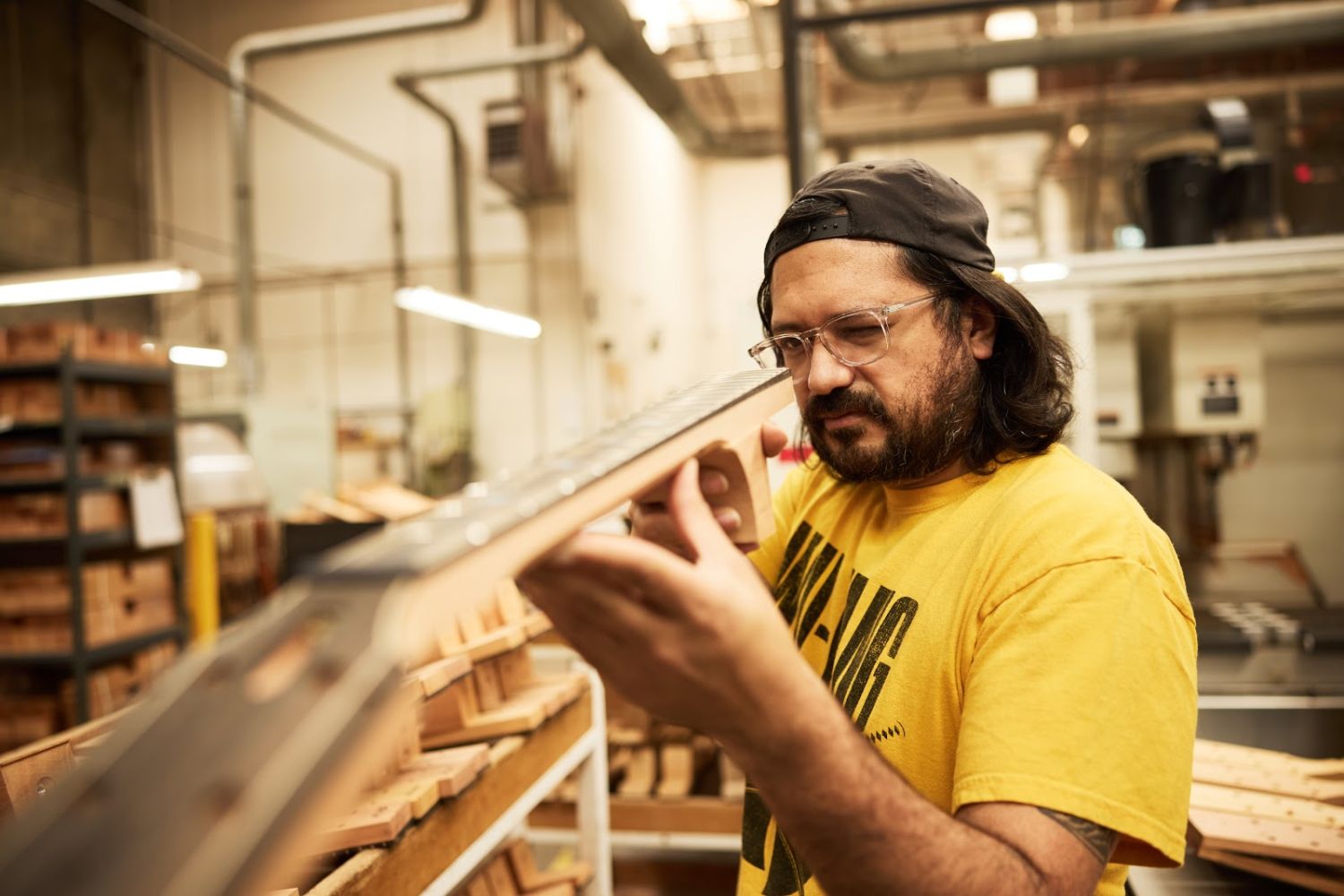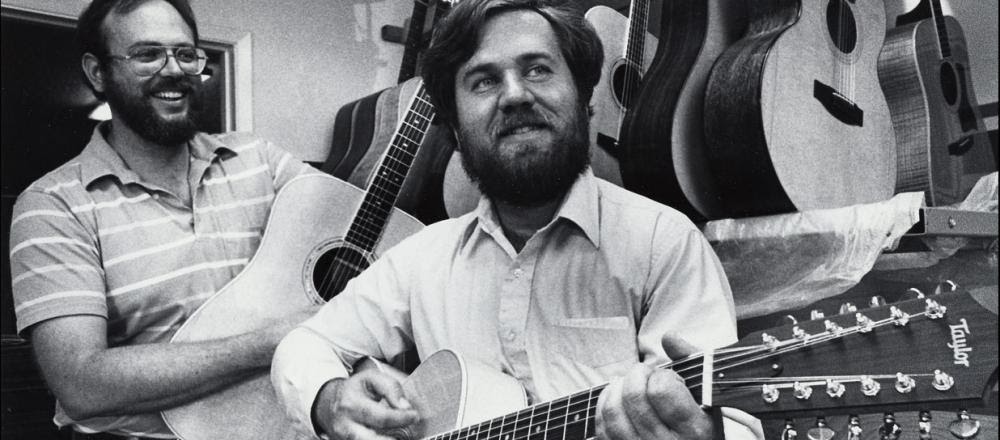Baby Boomers are retiring. Here’s what Canada should do to put their businesses in employees’ hands — and build community wealth.
Why It Matters
In the next decade, nearly three quarters of Canadian small business owners will retire – businesses worth over $1.5 trillion. Most will look to sell. In a country where the gap between the rich and poor is widening, and could do so exponentially in the pandemic’s aftermath, experts say this transition provides a huge opportunity to share wealth with workers.

In early January, Aldo Bustos stood in a factory parking lot in El Cajon, California and learned that he was about to become an owner of one of the top guitar manufacturers in the world.
Bustos is the day shift supervisor of the ‘neck division’ of Taylor Guitars, an American company that employs over 1,200 people and creates premium acoustic and electric guitars. He loves the “meditative” quality of the job, sanding the necks of the guitars as they pass through the production line. As a kid he grew up playing the air guitar. Now he and his colleagues build them and ship them to 60 countries around the world.
Just after the holidays, the company’s co-founders, Bob Taylor and Kurt Listug, gathered together their California-based employees, and announced over a 30-foot LED screen that they would transition to 100 percent employee ownership.
Bustos and his colleagues were thrilled.
“We were shocked,” he said. “Everybody was definitely in good spirits. Everyone was joking around, like, ‘Oh, hey there owner!”
“And [later] I brought it up with my team: like, ‘Hey, we’re all owners now. Let’s all put into practice the ‘ownership mentality’. Care about what you do and the equipment that you use. If you notice that the paint is chipping off of the wall – treat it like it’s your home. Wouldn’t you want to paint that or take care of that?’”
The transition was big for Bustos and his colleagues, but so too was it significant for a handful of onlookers north of the border. For one, the transition to employee ownership was financed by a Canadian pension fund – something, advocates say, that’s never happened before.
But perhaps more importantly, it highlighted something we don’t have here in Canada: legislation that easily enables and strongly incentivizes owners to sell their business to their workers. And it hinted at the impact of that absence: The potential that Canada will miss the opportunity provided by a flood of Baby Boomer retirements to curb rising inequality by offering working class employees a share of the wealth they’ve created.

In Canada, inequality is on the rise. Currently, the top 1 percent hold about as much wealth as the bottom 80 percent combined, according to a Federal government report. And recent research has shown that the gap may be widening even further as a result of the COVID-19 pandemic.
Since last March, the country’s top 44 billionaires increased their wealth by over $50 billion collectively – at the same time as many of the country’s lowest wage workers experienced reduced hours and job losses.
Amidst this backdrop of growing inequality, a significant demographic trend is underway that could offer an opportunity to buck the growing divide.
“We are facing a wave of [business] transitions over the next ten years,” said Jon Shell, managing director of Social Capital Partners, a Canadian non-profit that advocates for employee ownership. “It’s an acute issue.”
In the coming decade, nearly three quarters of Canadian small business owners will retire – businesses worth over $1.5 trillion, according to a 2018 report from the Candian Federation of Independent Businesses. These are construction businesses, farms, and bakery wholesalers that offer working class jobs in communities across Canada.
When they’re ready, the vast majority of these owners will look to sell or transfer their business, according to a CFIB survey.
For Canadian advocates, this wave of Baby Boomer-prompted business transitions creates a once-in-a-century opportunity to put company ownership in employees’s hands. “It’s a one-time deal,” said Shell. “…Once it’s done, it’s done.”
If harnessed right, it could also have a dramatic impact on reducing inequality.
In the US and UK, several studies have found that employee ownership is linked with higher wealth and higher pay for worker-owners. This pattern is especially strong for women and racialized employees. For instance, one American study found that the median wealth of Latinx households where employees are worker-owners was 12 times the wealth of the national median for Latinx households.
But despite the potential benefits, increased employee ownership in Canada is unlikely to happen without legislative intervention, says Shell.
For Canadian Baby Boomers looking for a buyer for their business, there are really only two viable options: “private equity or competitors,” he said.
But both of those options can be tough on workers and their communities.
When a competitor buys the business, they often do so because they’re able to find ‘synergies’ – corporate-speak for employee layoffs. This was recently the case in the merger between Cenovus Energy and Husky Energy, which Cenovus Energy officials have said could result in eliminating 20 to 25 percent of all jobs.
Private equity purchases (PE) too can result in job losses, suggest some studies. While some PE purchases offer businesses much-needed patient capital, others – and especially those that utilize ‘leveraged buyouts’ – also often result in staffing reductions. This occurs as a result of the hefty interest payments that purchased businesses take on to pay off the loans utilized in the corporate purchase. Both Toys “R” Us and Sears were purchased in this manner – a feature, say some experts, that contributed to them laying off tens of thousands of workers, including many in Canada.
But for business owners in the US and the UK, there’s another straight-forward (and tax incentivized option): selling the business to their employees.
In the US, this is done through Employee Stock Ownership Plans – or ESOPs, for short.

“We want to preserve Taylor’s values and the innovative culture we all love, which has been our recipe for success thus far and will keep us independent for the long-term future,” said Kurt Listug, co-founder and CEO of Taylor Guitars, by email.
“With employee ownership, we can provide for our employees in an even more substantive and meaningful way — by giving everyone a direct financial stake in the success of the company, which will keep the focus on making the best possible musical instruments for generations to come.”
In Canada, though legislation does allow for several types of employee ownership, including employee share ownership plans (an umbrella term for all corporate forms that offer some form of employee ownership), Shell says that none of the existing corporate vehicles are well-optimized or well-incentivized, for the “vast number of regular, privately-owned companies.”
Worker co-ops are owned and democratically-run by their employees – a feature that may demand a little more democracy than many Boomer owners might like.
For their part, stock options plans reward employees for their start-up ‘sweat equity’, making them popular with tech company founders, but provide a shallower form of ownership than equity-minded advocates might hope for. They offer employees the option to purchase company shares, but don’t automatically provide all workers with a stake of the company, as in the case of the Taylor Guitars’ transition.
And finally, other types of Canadian ESOPs are not easily facilitated using existing corporate vehicles, say advocates.
“The time and effort to implement is significant,” said Mark Kuznicki, co-founder of The Moment, a Toronto-based innovation design firm which recently became an ESOP. “In some ways, it feels like Canadian corporate law does not make it easy to do this. You have to do a lot of work and work-arounds.”
“If I were sixty-five or seventy, I’d be like, ‘I want out now!’ [Instead,] what I’m looking at is that I want to be out in twenty-five years, so I can be patient and wait for the little engine to tick over.”
In the US and UK, federal ESOP legislation offers two things that advocates say are missing in Canada to allow for transitions like the one initiated by the owners of Taylor Guitars. The first is a new type of corporate ‘trust’ to make the shift easy. The second is new tax incentives to make the transition attractive.
With respect to the former, both the US and UK have developed corporate trusts that are purpose-built to enable employee-ownership transitions. (In the UK, these are referred to as employee ownership trusts – or EOTs for short).
In Canada, no such purpose-built trust exists. And, while it is technically possible in Canada to jerry-rig a trust with all of the necessary features, it’s very complex, and can penalize worker-owners with added capital gains tax, according to research by Social Capital Partners.
“The whole system of ownership of for-profit companies is premised on the notion of a small number of shareholders,” said Peter Dietz, co-founder of Grantbook, a technology consulting firm that became an ESOP in 2020. This makes things complicated for Canadian ESOPs.
“Any documents that need to be signed by all shareholders now needs to be signed by all employees who are shareholders,” said Dietz – no easy feat when you’ve got a small soccer team of employee-owners.
Further, US and UK legislation makes it easy for a company to finance the transition using patient capital from an institutional investor. This provides owners with a simple way to sell their shares, helping to fund their retirement.
It also enables working-class employees to become owners without having to pay for the shares with cash at the moment when the owner is looking to sell.
“I can see that happening for a small mom and pop shop,” said Bustos, of the prospect of ESOPs that can buy-out the owner all at once.
“But say it’s a large company like ourselves with the reputation and all of the buildings and employees that we have – that would be a huge bill, I think, for all of the employees. I can’t even imagine what that cost would be.”
In the case of Taylor Guitars, the newly-created company trust received loans from the owners themselves, Social Capital Partners, and Healthcare of Ontario Pension Plan (the pension plan of 380,000 healthcare workers in Ontario) to purchase the company on behalf of the workers.
Notably, this is the first time a Canadian institutional investor has ever financed an American ESOP transition, according to Shell – a significant milestone in Canadian ESG investing history. It’s also a powerful demonstration of how Canadian pension fund dollars could be used here in Canada to benefit two groups of working class people: pension fund holders and future ESOP worker-owners.
“We evaluated a number of potential financial partners, but it was key for us to work with someone who shared our values and long-term outlook,” said Bob Taylor, co-founder and president of Taylor Guitars, by email.
“Both HOOPP and Social Capital Partners really believe in employee ownership as a way of tackling wealth inequality and would like to see Canada offer plans similar to the US ESOP to companies in Canada.”
Alongside the establishment of a new type of trust, advocates also say that new tax incentives could spur a wave of new Canadian ESOPs.
In the US, federal legislation enables owners to eliminate or delay taxes on the sale of the company when they use an ESOP. It also often allows companies to eliminate federal and sometimes state income tax on the portion of the business owned by the ESOP, according to the US-based ESOP Association.
But there’s no such incentivization in Canada, according to experts.
Yet despite these challenges, a cohort of determined Canadian companies do decide to become ESOPs and offer broad-based worker ownership. And given the resource-intensive nature of ESOP establishment in Canada, the owners who do make the shift are often driven by a strong ethical imperative; and a long-term orientation toward the businesses’ economic success.
“When value gets generated, it should not go to people who have nothing to do with the day-to-day business,” said Dirk Propfe, CEO of ET Group, a consulting business that became an ESOP in 2019.
“The value that gets generated needs to be distributed amongst the people who are generating the value. So that’s where ESOP was the natural evolution for our structure.”
At The Moment, the motivation was similar.
“We saw it as having a number of potential benefits. Chief among those being strong motivation for everyone, aligned incentives between all of us, and truly – it’s not that power is equalized – but it’s much more balanced,” said Kuznicki.
These sorts of benefits have been borne out across time and in different geographies. Studies have shown that ESOPs are linked with improved corporate performance, stronger local economies, and higher income and wealth for workers.
And for new employee-owners, this connection is obvious.
“It’s like a hat I put on as I’m thinking about things,” said Chelsea Omel, an innovation designer and new employee-owner of The Moment. “There’s sort of this point of view that is also this owner’s point of view. It encourages me to step back and think: ‘Ok, as a shareholder, is this what I should be working on?’ That’s been the mindset shift that I’ve noticed.”
Jason Chong, an AutoCAD designer at ET Group, shared a similar sentiment. Last year, he jumped at the opportunity to purchase shares in his Toronto-based employer.
“From a business owner perspective, if you sell shares of your company, it gives you that confidence that your employees care. That they have faith in their work,” he said.
“Because no one would invest their money in a failing venture.”

Yet despite the upsides of promoting greater employee-ownership, the development of a new ESOP regime in Canada is far from a sure thing.
“When we talk to the people who have been involved with this for decades, they say, ‘You don’t get parades in the street to demand employee-ownership,’ but [then again] nobody’s against it,” said Shell.
If Canada does implement a new regime, the experience of the US and UK would suggest that new employee-ownership should follow along promptly.
In the US, ESOP legislation was passed in 1974. Since then, the number of employee-owned companies has grown rapidly. Currently, 10.6 million American employees participate in ESOPs; and through this ownership, they hold $1.377 trillion in total value – an average of $129,521 per employee, according to The ESOP Association.
So too are they growing in popularity in the UK.
In 2014, new legislation was passed that enshrined employee ownership trusts into law. Since then, 314 new EOTs have been created, offering ownership to 28,000 employees, according to Employee Ownership Association data.
And for many of those employees, becoming an owner is no small thing.
“It makes me feel a bit more secure about retirement,” said Bustos. “We’re already really well taken care of at Taylor…but this is amazing.”
“Once I leave the company I know I’m going to take a little extra for all of my years of hard work and dedication at Taylor.”
